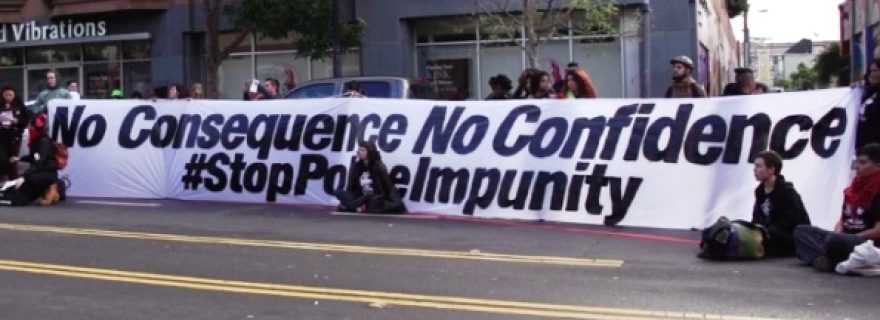Confrontational Self-Organization: Some Reflections from Oakland and San Francisco
From Occupy to Black Lives Matter, the Californian cities of Oakland and San Francisco are on the frontlines of some of today's most important political struggles. In these cities systemic inequality and racism is palpable in every aspect of urban life.
We live in tumultuous times. Not equally tumultuous for everyone to be sure, but tumultuous nonetheless. Since September 2014, I have been living in Oakland, California working on a research project on digital technology and citizenship. I had been to Oakland before, including a trip in January 2012 to co-produce the film 'The Oakland Commune' about the Occupy Movement.
Confrontational self-organization
In 2012, my co-producer Brandon Jourdan and I came to Oakland to see with our own eyes the movement that had quickly become known as the most successful and most radical incarnation of Occupy in the US: and it did not disappoint. The Oakland encampment, although it had already been evicted from the occupied square by the time we arrived, was still meeting every day and planning several large-scale actions. The ethos was defined by an anti-authoritarian, anti-government, and anti-police attitude that made it an appealing political space for people from many different backgrounds and experiences.
This attitude of confrontational self-organization has longstanding roots in Oakland, which is the birthplace of Black Panther Party and ground zero for the 2009 Oscar Grant riots, named after the young black man who was shot and killed by the BART-police (Bay Area Rapid Transit police). Oakland is also across the Bay from San Francisco and just down the road from Berkeley, famous for the free speech movement in the mid-1960s and where, in 2009, students staged an occupation of Wheeler Hall on Berkeley campus as part of a series of actions and a wave of occupations that spread to multiple universities.
In 2009, the idea of occupation was radical for the US – it had been a long time since people had taken and tried to hold space as a political act. In fall 2014, the students who re-occupied Wheeler Hall had a shared frame of reference to build on. It was not the Occupy protests of 2011, but rather the wave of student occupations in 2009 that turned the slogan “Occupy Everything” into a national call to action in the US.
The Oakland Commune. By Global Uprisings at Vimeo.
Government as absent slumlord or worse
Fast forward to November 2014. I'm standing on the corner of 14th and Broadway in downtown Oakland, right next to the plaza that was occupied in 2011, officially called Frank Ogawa plaza, but known to everyone as Oscar Grant plaza. The streets are overflowing with people who have just heard Prosecutor Robert McCulloch announce live on television or via livestream that there would be no indictment of police officer Darren Wilson for the murder of Michael Brown in Ferguson, Missouri. The decision was no surprise. But the anger was palpable. Faith in government among people in Oakland, especially among the protesters that night, is virtually non-existent. For many in Oakland, the government is at best an absent slumlord and at worst the one pointing the gun at you, pulling the trigger – no questions asked.
Alienation runs deep. The hypocrisy of democracy is as clear as day on the streets of Oakland and San Francisco. The experience of every day, simply of living, reinforces the message that democracy is not for everyone. In San Francisco the richest technology executives and homeless residents of the street live side by side – for now. In Oakland the hills are home to mansions with beautiful views of sunsets over the Bay, while the city as a whole regularly ranks among the top four most dangerous cities in the United States – which, given the level of poverty and violence throughout the US, is no small statement.
Connecting police violence and gentrification
The blatant racism of the police forces, most visible in the large number of police shootings of black people, also serves to reinforce the perception that democracy is not equally for everyone. It is no surprise then that activists in the Bay Area have been trying to connect the high levels of police violence against black and brown people to the rapid rate of gentrification in both cities – which is resulting in increased policing of, and ultimately displacement of, black and brown communities.
San Francisco Police Department Blockade: March 23, 2015. By Global Uprisings at Vimeo.
The Black Lives Matter movement that swept across the US at the end of 2014 is perhaps no longer making national headlines, but it is very much alive and fighting in the Bay Area. The number of police killings continues to be alarming, with three people shot and killed in San Francisco in just three months and several more in Oakland. Even just the other day (22 March 2015) there were three police-involved shootings in the Bay Area in just an eight-hour timeframe.
The Occupy movements that spread across the US in 2011 and 2012 started a conversation about economic inequality and the legitimation crisis facing representative democracy. But these movements hardly even scratched the surface of this enormous problem that encompasses economic inequality, racism, police impunity, the violence of the state, the political limits of democracy, and the unequal distribution of people's ability to determine for themselves the most important aspects of their own lives. Whether or not your vantage point allows you to see it, we live in tumultuous times, and unless radical changes take place, it is unlikely that the waters will calm anytime soon.



0 Comments
Add a comment